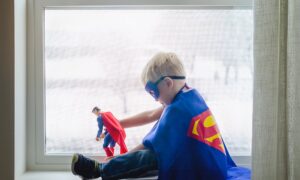– An important lesson to give all children
Whether it be at home or in the schoolyard, how often does one child come to you to tell you about another child’s wrongdoing? You confront that other child, ask what they did, and you get a completely different answer to the situation. Was one of them being dishonest, or do they have a different perspective of the event? There is a high chance that you won’t ever get the right story. What can you then do about it? I teach my students how (and why) to be honest, and how to understand perspective! Read on to learn how to teach honesty and the understanding of perspective.
Honesty
Honesty is a fundamental trait to have as a human. Being known as an honest person means other people will trust you. They will trust your word and believe your story that you tell. However, if you are known as dishonest, then people perceive you as the opposite to honest. Dishonest people lose others’ trust, they do not believe, or cautiously believe, the stories you tell and the information you give.
To my students, I often preach the metaphor of honesty behind the book, ‘The Boy Who Cried Wolf!’ I question my students, with the future scenario, “what if you were known as dishonest, and at the time you truly needed help, who will believe you and help you?” Then I link them to a real-life moment that may have happened to them already. “Have you ever been in trouble for something you didn’t do, and then when you were being honest, you were not believed?” With that question, usually, all of my students have raised their hand!
Next
The next lesson I teach my students are the implications of punishments that may occur from lying. I often tell them “In the court of law, by doing the wrong thing, you get punished and can go to jail. But if you lie and are later caught for lying, the punishment becomes worse. Is that risk worth taking?”
I often bring this up to my students when they have done the wrong thing, allowing them the opportunity to answer truthfully. My students will then process what I have just said and then think of the consequences, followed by the truthful answer. I then usually thank them for their honesty, and if their ‘mishap’ is minor, I may even make the punishment minimal, detailing that I have done that because they were honest. Reducing the punishment also trains the students to be honest from the start. They see the benefits of honesty and the detriments of dishonesty.
Finally
For the students who do not care how dishonesty can negatively impact themselves, I teach them how their dishonesty can affect others. I will tell a story (usually fake, but it doesn’t have to be) of how someone’s lying has hurt another person. It can be as drastic as “Luke lied to Tony about his address for fun. Tony went to that wrong address. Tony was kidnapped and never seen again!” Or as simple as “Jessica lied about Mikayla swearing. Mikayla got in trouble by the school, and as a consequence, missed out on the excursion. Mikayla was never friends with Jessica again!”
As we are all different human beings, we all have various motivating factors towards our actions. Some of us are motivated by things that impact ourselves; others are motivated by things that affect others. In the classroom, you will likely have a mix of these motivating factors; therefore, I tend to have a class discussion and discuss both scenarios.
Perspective
Perspective! Something that is not only lacked by children but lacked by many adults as well. We are quick to assume the reasons behind another human’s actions, but what we need to be is quick to understand the reasons behind those actions. There are many ways to teach perspective, some are easier than others, and some are more powerful than others.
Gather the perspectives
When my students are still developing their understanding of perspective, I start by using perspective as an example in a real-life; in-the-moment situation. For example, when Maria comes up to me at the end of recess, distraught that Harry had slapped her during a game of chasey, I aim to gather as much information as possible so that I can envision it like a movie. By doing this, I have gained more information from Maria. I now know that Harry’s slap was ‘in-game’ as Harry chased Maria to tag her. I then talk to Harry.
Harry’s information backed-up Maria’s story, although in Harry’s story, he detailed that he was trying to tag Maria, not slap her. As an adult, I now understand both perspectives. Harry was trying to do the right thing whilst playing chasey, trying to tag Maria. Harry’s tag was a little too rough for Maria, and Maria thought he deliberately slapped her.
Now that I know the correct story, I handle it and use it as a teaching moment. I explain both perspectives to Maria and Harry. Harry apologises for tagging her too hard and will try to tag softer the next time. No punishment needs to happen as no one had done the wrong thing as it was just an accident. I then teach this to the class by telling the class this story. I teach them to understand that no one intentionally did the wrong thing; it was just a different perspective between the two.
Next
Once my students obtain a more robust understanding of perspective, they’re ready to look for the reasons behind someone’s actions. I use the metaphors ‘walk in that person’s shoes’ and ‘envision that you are that person, and see, hear and feel what they do.’ Then, I guide them through an intense story about someone’s complicated life. Setting the goal for my students to first try and feel what this person may feel, then predict how this person may act, and finally try to reason why this person acted that way. I would tell the story of a boy (at their age) whose family had no money to pay for clean clothes, food and electricity. If the students were older and more capable of understanding, I might add an abusive parent within the story.
Furthermore, I will talk about how this boy is often cold, hungry, and possibly even traumatised, hence why he struggles with sleep at home. I then add to the story what his school life may be like, such as how he may fail at school, struggle to make friends, often get into trouble, and possibly get into fights. Finally, I would link the reasoning behind his actions in school with his home life.
End game
The students will then start to understand how a person’s life out of school, may be the reason for their harmful actions within a school. I ask the students, ‘what can they do to help, even if a person going through this pushes others away?’
Most will say that they will try and be this persons friend or give them food and clothes. However, the message I end with is that maybe all this person wants is for them to understand and care. And within the schoolyard, sometimes to understand and care is all another student can do!
Teaching honesty and perspective is no easy task, and I hope that something here can help you or another person.
Read here to learn how a mentor can positively impact a child.
Please help spread this information to others by commenting on any questions and ideas, tagging others and sharing.
Regards,
Educationalist





